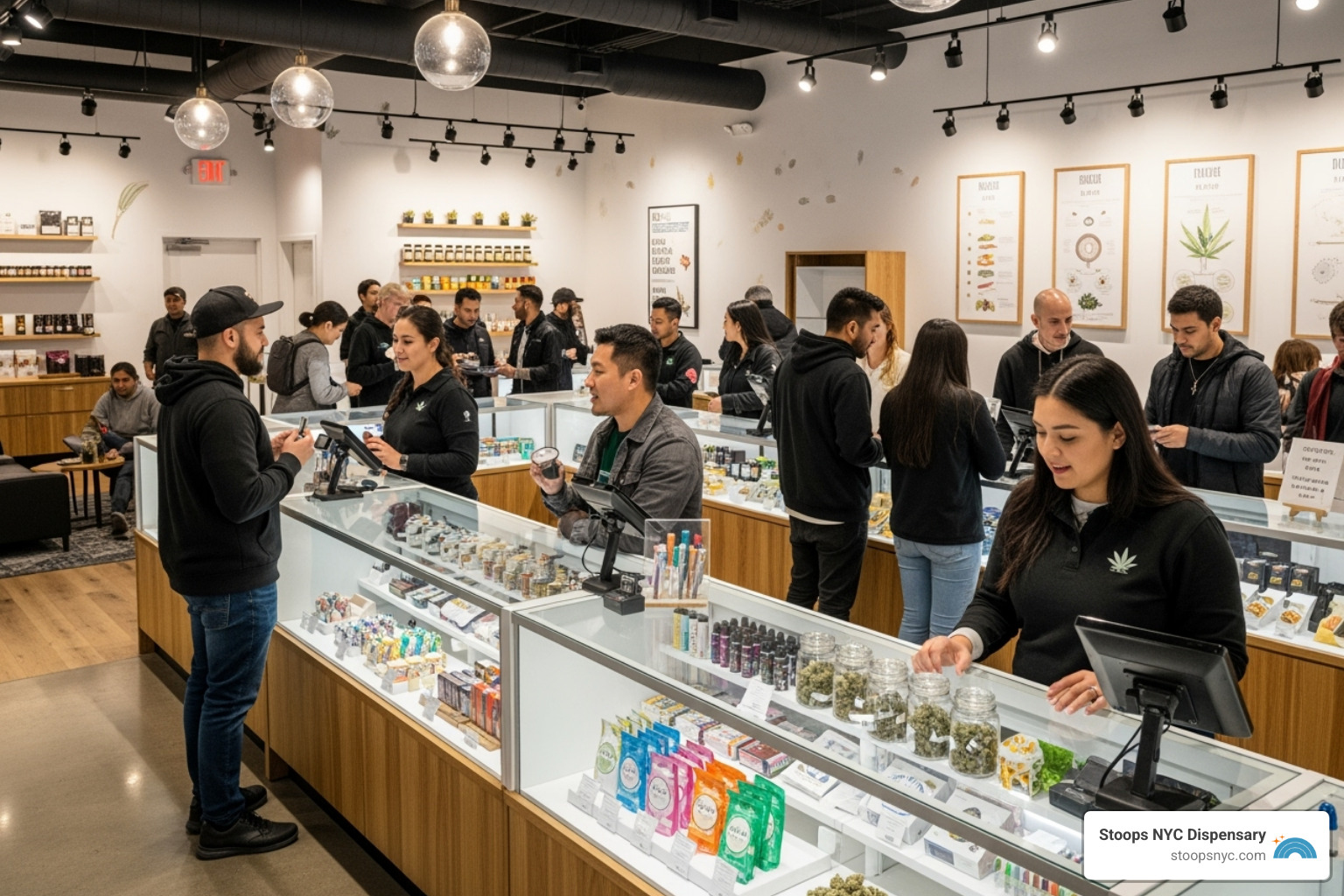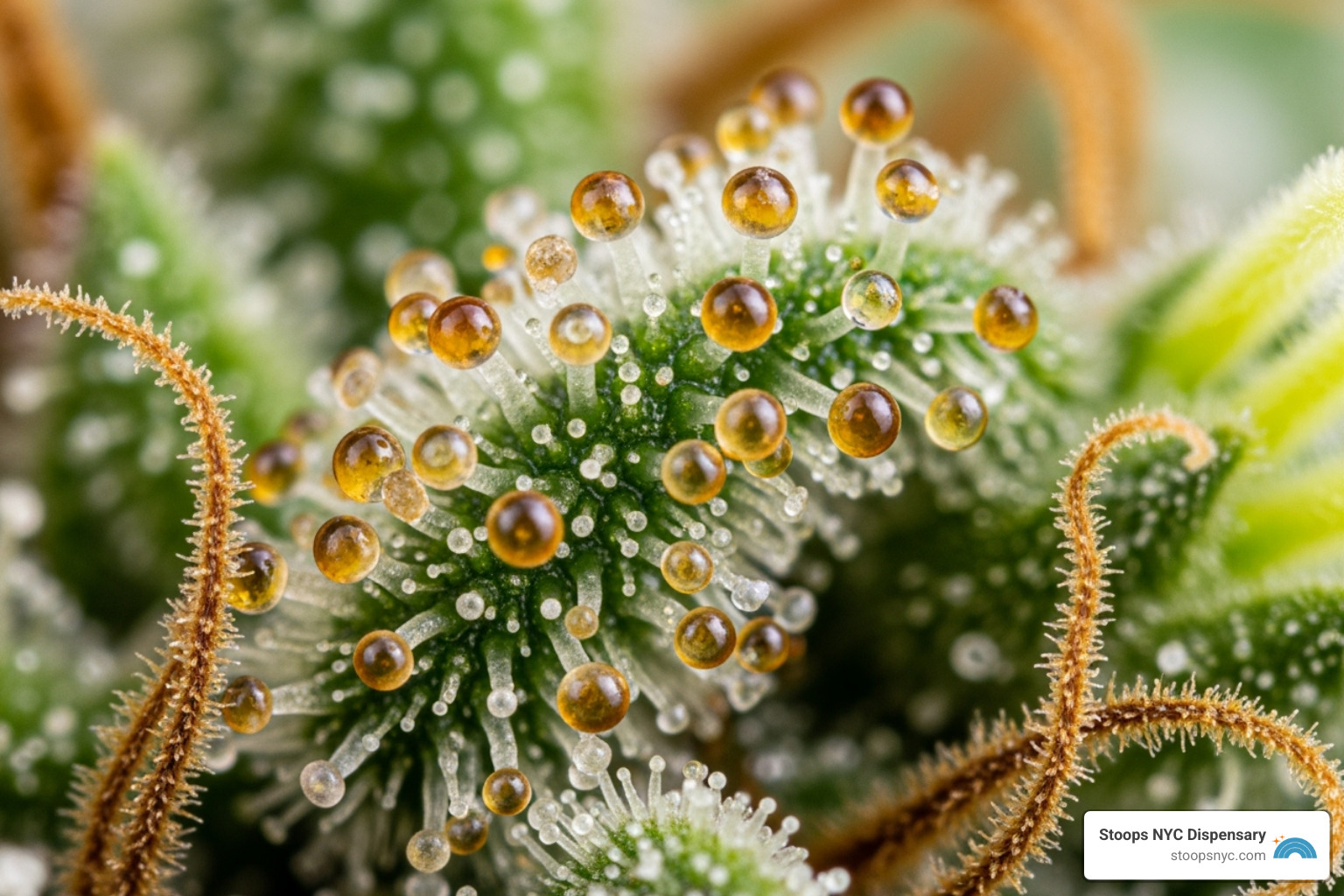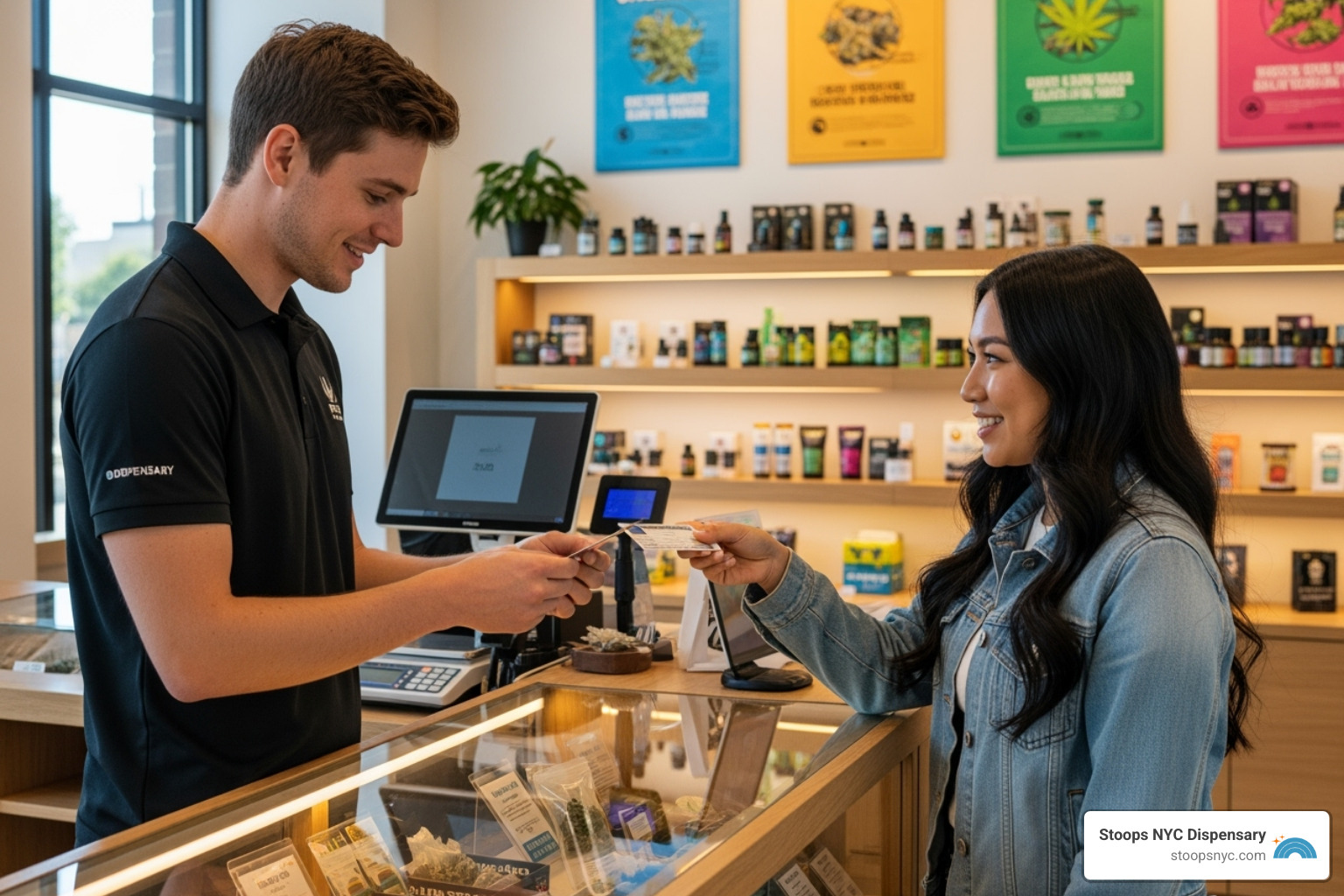Why Cannabis Facts for Budtenders Are Essential for Success
Cannabis facts for budtenders are the foundation of exceptional customer service and professional growth in today’s rapidly evolving cannabis industry. Whether you’re new to the dispensary floor or looking to sharpen your expertise, mastering these essential facts can transform you from a basic sales associate into a trusted cannabis educator and guide.
Essential Cannabis Facts Every Budtender Should Know:
- THC vs CBD: THC creates psychoactive effects, while CBD is non-psychoactive but offers therapeutic benefits.
- Terpenes: Aromatic compounds that influence flavor and effects (myrcene = relaxing, limonene = uplifting).
- Onset Times: Smoking/vaping takes 2-10 minutes; edibles take 30 minutes to 2 hours.
- Dosing Rule: “Start low, go slow” is especially critical for edibles.
- Legal Limits: In New York, adults can possess up to 3 ounces of flower and 24 grams of concentrates.
- Product Types: Flower, vapes, edibles, tinctures, topicals, and concentrates each serve different needs.
- Customer Service: 78% of customers abandon purchases due to poor service experiences.
I’m Chris Kuilan, Co-Founder of Stoops NYC, and over the past two years of building our Manhattan dispensary, I’ve seen how cannabis facts for budtenders directly impact customer satisfaction and business growth. My experience navigating New York’s cannabis landscape has taught me that knowledgeable staff are the difference between a one-time visitor and a loyal community member.

Explore more about cannabis facts for budtenders:
The Budtender’s Blueprint: More Than Just a Sales Role
The role of a budtender has evolved far beyond a simple sales job. Today’s budtenders are educators, scientists, guides, and compliance officers—all crucial to a dispensary’s success. As the cannabis industry grows, so does the demand for skilled professionals.
While the average hourly wage for a budtender is around $18, top performers bring immense value. At Stoops NYC, our best budtenders can earn $30-$35 per hour with tips. This reflects a key industry insight: there’s a 64% performance gap between the best and worst budtenders. When underperformers reach just the average level, revenue per ticket can grow by about 31%. This isn’t just about selling more; it’s about creating trusted experiences that keep customers coming back.

Why a Great Budtender is a Dispensary’s Biggest Asset
Your budtender is often the first and last person a customer interacts with, setting the tone for their entire visit. A negative interaction can be costly; 78% of customers have backed out of a purchase due to poor service. At Stoops NYC, our knowledgeable staff prevent this by creating positive, educational interactions.
A great budtender builds relationships and fosters trust, making customers feel comfortable and respected. This personalized approach increases loyalty and sales. Beyond customer service, skilled budtenders ensure smooth operations by managing inventory, handling payments, and maintaining legal compliance.
The Makings of a Successful Budtender
What separates a good budtender from a great one? It’s a combination of personal qualities and honed skills.
- Passion for cannabis: Genuine interest in the plant and its benefits is contagious and builds authentic connections.
- Eagerness to learn: The industry is always changing. The best budtenders stay curious and adapt quickly.
- Empathy and active listening: Understanding a customer’s needs and experiences is key to providing helpful guidance.
- Strong communication skills: Explaining complex topics simply and clearly is essential for educating customers.
- Adaptability: Handling rushes, new regulations, or unexpected customer situations with grace is vital.
- Professionalism: Even in a relaxed environment, respecting privacy and adhering to compliance standards is paramount. Our budtenders are brand ambassadors for Stoops NYC. More on building creative brand names and reputation – the principles of consistency and positive representation apply directly to how professional budtenders embody our brand values every day.
Cannabis Science 101: The Core Knowledge Every Budtender Needs
Understanding cannabis science is essential for providing real value. Grasping how the plant works at a molecular level allows you to offer recommendations based on chemistry, not guesswork. This scientific foundation is what separates great budtenders from order-takers.

Deconstructing the Plant: Cannabinoids and the Endocannabinoid System
The cannabis plant produces over 100 compounds called cannabinoids. You only need to focus on the most common ones to guide customers effectively.
- THC (Tetrahydrocannabinol): The primary psychoactive compound responsible for the euphoric “high.” It binds to receptors in the brain, influencing mood, appetite, and perception.
- CBD (Cannabidiol): A non-psychoactive cannabinoid popular for its potential therapeutic benefits, such as relaxation and wellness support. Our CBD Gummies in New York are a great example of products that offer CBD’s benefits without a high.
- Other Cannabinoids: CBN (Cannabinol) is associated with sedating effects, while CBG (Cannabigerol) is a precursor from which other cannabinoids are formed.
These compounds interact with our body’s Endocannabinoid System (ECS), which helps regulate sleep, mood, appetite, and pain. Since everyone’s ECS is unique, cannabis affects people differently. This explains why the same strain can be energizing for one person and relaxing for another. A scientific overview of cannabinoids highlights these complex interactions.
The Aromatic World of Terpenes
If cannabinoids are the engine, terpenes are the steering wheel. These aromatic compounds create the plant’s scent and flavor, but more importantly, they influence the effects—a concept known as the “entourage effect.”
- Myrcene: Earthy and musky, often linked to relaxing or sedating “couch-lock” effects.
- Limonene: Bright and citrusy, commonly associated with uplifting, mood-boosting effects.
- Pinene: Smells of fresh pine and is thought to promote alertness and memory retention.
- Caryophyllene: Spicy and peppery, it’s unique for its ability to interact with the ECS and is sought for its potential anti-inflammatory properties.
You can find more details in our Detailed Terpenes Information section or explore specific profiles like Geraniol. A strain’s terpene profile is often a better predictor of its effects than its THC percentage.
Beyond Indica vs. Sativa: A Modern Approach to Strains
The old “indica for sleep, sativa for energy” rule is outdated. Most cannabis today is hybrid, and its effects depend more on its unique chemical profile (chemovar) of cannabinoids and terpenes than its classification. A myrcene-heavy “sativa” could be sedating, while a limonene-rich “indica” could be energizing.
We encourage customers to look at lab results and terpene profiles rather than just the indica/sativa label. While we categorize our flower as Indica Flower, Sativa Flower, and Hybrid Flower, we explain these are starting points, not guarantees. The modern approach is to match customers with chemical profiles that align with their desired effects.
A Guide to the Dispensary Menu: Products and Consumption Methods
A dispensary menu can be overwhelming. As a budtender, your role is to guide customers through the diverse landscape of products. Matching the right product to a customer’s needs, experience, and lifestyle is one of the most critical cannabis facts for budtenders to master.

Inhaled Methods: Flower, Vapes, and Concentrates
For fast effects, inhaled methods are the top choice, as cannabinoids enter the bloodstream directly through the lungs.
- Dried Flower: The classic choice, smoked or vaporized. Effects begin in 2-10 minutes and last 1-3 hours, making it easy to control the experience. Our Pre-Rolls offer a convenient option.
- Vaporizers and Cartridges: A popular choice for discretion and smoother hits. Vaporizers and Carts heat cannabis without combustion, offering a cleaner, more flavorful experience with a similar onset time to smoking.
- Concentrates: High-potency extracts for experienced users. Concentrates like shatter, wax, and live resin offer powerful effects. Older forms like hash and modern solventless options like rosin are also available. RSO (Rick Simpson Oil) is a full-spectrum oil that can be consumed orally.
Oral and Edible Options: From Gummies to Beverages
Oral methods provide a different experience, with effects that are slower to start but last much longer.
- Edibles: When cannabis is digested, the liver converts THC into a more potent, longer-lasting compound. This explains why edibles feel more intense. Our Edibles range from gummies to Gourmet Cannabis Edibles.
- Beverages and Tinctures: Cannabis Beverages may offer a quicker onset than solid edibles. Tinctures are taken sublingually (under the tongue) for even faster absorption, with effects typically felt in 15-45 minutes.
The golden rule for all oral methods is “Start low, go slow.” We recommend a 2.5-5mg THC dose, waiting at least two hours before consuming more.
Comparing Common Cannabis Consumption Methods
| Method | Onset Time | Duration | Best For |
|---|---|---|---|
| Smoking (Flower) | 2-10 minutes | 1-3 hours | Immediate effects, social settings, easy dosage control. |
| Vaping (Flower/Cart) | 2-10 minutes | 1-3 hours | Immediate effects, smoother hits, discretion, flavor. |
| Dabbing (Concentrates) | 1-5 minutes | 1-3 hours | Strong, immediate effects for experienced users. |
| Edibles | 30 minutes – 2 hours | 4-8+ hours | Long-lasting effects, discretion, precise dosing. |
| Tinctures (Sublingual) | 15-45 minutes | 2-6 hours | Faster onset than edibles, precise dosing. |
| Topicals | 10-30 minutes | 2-4 hours | Localized, non-psychoactive relief for muscles or skin. |
| Capsules | 30 minutes – 2 hours | 4-8 hours | Precise, discreet, tasteless dosing with edible-like effects. |
The Professional Budtender: Essential Cannabis Facts for Budtenders on Safety, Service, and Compliance
A professional budtender is an educator, compliance officer, and trusted advisor. The most important cannabis facts for budtenders are those that ensure safety and build strong customer relationships. Professionalism isn’t about being formal; it’s about being reliable, knowledgeable, and caring.

Essential cannabis facts for budtenders: Navigating New York’s Legal Landscape
Cannabis is a heavily regulated industry. In New York, compliance with the Office of Cannabis Management (OCM) is essential to protect customers and the business. Key regulations include:
- Age Verification: We check every government-issued ID to ensure customers are 21 or older. No exceptions.
- Purchase Limits: Adults can legally possess up to 3 ounces of cannabis flower and 24 grams of concentrated cannabis. We track these limits carefully.
- Packaging and Testing: All products are sold in child-resistant, opaque packaging. Every item is lab-tested for contaminants and to verify cannabinoid and terpene content.
Understanding these Cannabis Legalization Facts and OCM guidelines helps us serve customers responsibly. You can find official information from New York’s Office of Cannabis Management (OCM).
The Art of the Recommendation: Key cannabis facts for budtenders to guide customers
Great recommendations come from understanding the customer, not just the product.
- Listen and Ask Questions: Go beyond “Indica or Sativa?” Ask open-ended questions like, “What kind of experience are you hoping for?” to understand their true needs.
- Identify Customer Needs: New users require patience and clear guidance on dosing, while experienced users might want to discuss terpenes or new product types.
- Set Expectations: Be honest about onset times, duration, and potency. This builds trust and prevents negative experiences. For edibles, always stress the delayed onset.
- Recommend for Effect, Not Medical Treatment: We are not doctors. Use effects-based language like, “Customers often choose this for relaxation,” rather than making medical claims. For specific conditions, always encourage customers to consult a healthcare professional. Our guide on Weed Strains for Anxiety is a resource they can explore independently.
Mastering regulatory knowledge and genuine empathy makes you more than a salesperson—it makes you a trusted guide.
Frequently Asked Questions about Being a Budtender
Here are some of the most common questions we hear from new budtenders at Stoops NYC.
What are the most important facts a new budtender should learn first?
Focus on the fundamentals that keep customers safe and happy. Master the difference between THC and CBD, the “start low, go slow” rule for edibles, and all compliance procedures. Knowing how to check IDs and explain New York’s purchase limits correctly builds immediate trust and protects both the customer and the dispensary.
How do I recommend a product without giving medical advice?
This is crucial. Use effects-based descriptions instead of medical claims. For example, instead of saying a product “treats anxiety,” say, “Many customers find this strain relaxing.” You are sharing anecdotal experiences, not making medical promises. Always refer customers to healthcare professionals for medical conditions. Our Cannabis and Mental Health Fact Sheet is a helpful resource for them to review.
What’s more important for predicting effects: THC percentage or terpenes?
While customers often ask about THC percentage, terpenes are often a better predictor of a product’s effects. Two strains with the same THC level can feel completely different due to their terpene profiles. A strain high in limonene might be uplifting, while one high in myrcene could be sedating. Educating customers on how terpenes shape the high helps them find the right product more reliably than just chasing high THC numbers.
Conclusion
Your journey as a budtender is one of continuous learning. The cannabis facts for budtenders covered here—from science to service—are your foundation. As the industry evolves, staying curious and informed will make you an invaluable resource.
You are more than a salesperson; you are a cannabis educator and a trusted guide. At Stoops NYC, we see daily how knowledgeable staff transform transactions into meaningful conversations, building a loyal community. The difference between an average and a great budtender lies in the commitment to learning, listening with empathy, and sharing your passion for this incredible plant.
Your professional development is an ongoing process. The more you invest in your knowledge, the more you contribute to your dispensary and the entire cannabis community. Ready to deepen your expertise? Explore our comprehensive resources on cannabis education.
FAQ
How often should I update my cannabis knowledge as a budtender?
The industry changes fast, so aim to learn something new weekly. Follow industry news, attend trainings, and stay current on New York’s regulations to provide the best service.
What’s the best way to handle a customer who’s had a bad cannabis experience?
Listen with empathy. Ask what happened, as bad experiences often stem from incorrect dosing or product choice. Use your knowledge to suggest a different approach, always emphasizing a low starting dose.
How do I stay compliant while still providing excellent customer service?
View compliance as part of great service—it protects everyone. Be transparent when checking IDs and explaining purchase limits. This professionalism builds trust.
What should I do if I don’t know the answer to a customer’s question?
It’s okay not to know everything. Be honest and say, “That’s a great question, let me find out for you.” Ask a manager or senior budtender. Customers appreciate honesty over incorrect information.
